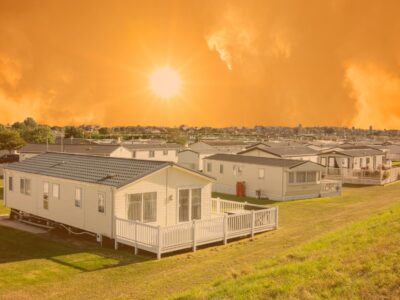California Seeks to Protect Homes from Excessive Indoor Heat
Legal Planet: Environmental Law and Policy 2024-05-08


Guest contributor Cassandra Vo is a J.D. Candidate at UCLA Law (’25) specializing in environmental law.
Hotter, deadlier, and more frequent heat waves have become one of the most surefire signs of a changing climate in our day-to-day lives. California recognized the need for action on this issue in 2022 by bringing to life AB 209, one section of which centers around creating better indoor heat safety in homes. That should include mobile home communities, which are too often left out of this discussion.
Specifically, AB 209 requires the state’s Department of Housing and Community Development (HCD) to do two things: (1) recommend a maximum safe indoor air temperature for all “residential dwelling units” statewide, and (2) recommend policies that ensure these units can maintain that temperature. HCD must deliver these policy recommendations in a report to the California Legislature by January 1, 2025. To do so, HCD has partnered with UC Berkeley’s Center for the Built Environment to accomplish these two tasks; together, they are collaborating on this project as the AB 209 Stakeholder Working Group.
One function of the Stakeholder Working Group is, of course, to consult with stakeholders—including community-based organizations who work in housing and health, tenant rights, and environmental justice. The Working Group hosts quarterly meetings where they share the latest updates and substance of their work, then allow stakeholders to comment and ask questions in response.
So far, these meetings have focused on important, but narrow, technical details concerning the Working Group’s development of a recommended safe indoor air temperature. The group has not yet shared ideas for policies that would help ensure homes can maintain a maximum safe indoor temperature. And not much has yet been said about protections for mobile homes, which are a critically important part of the heat resilience puzzle.
More than 5,000 active mobile home parks provide a source of affordable housing for 1.6 million Californians. But because mobile homes tend to be decades older, less equipped to deal with heat waves, and located in high heat exposure areas, climate disasters like extreme heat are more likely to impact mobile homes than any other housing type. This means that these mobile home residents can end up six to eight times more likely to die from heat-related causes compared to residents of other housing types. These vulnerabilities are even worse in many of California’s Polanco parks, which are informal mobile home communities—primarily comprised of Latino immigrants and their families—that lack proper infrastructure in the Eastern Coachella Valley and surrounding areas. Including mobile homes in the scope of the Working Group’s report is a crucial first step to preventing avoidable deaths as the climate continues to warm.
As a student in UCLA’s Frank G. Wells Environmental Law Clinic, I had the opportunity to support advocacy by the nonprofit Leadership Counsel for Justice and Accountability (LCJA) to help ensure that the Working Group consider and recommend robust protections for mobile home dwellers as part of its work. This support took the form of providing testimonial statements to the Working Group at its March 5 quarterly meeting, as well as writing a formal comment letter this past April.

The comment letter, signed by LCJA and two of its coalition partners (the California Rural Legal Assistance Foundation and the Greenlining Institute), urged the Working Group to consider the following points in its work:
- Including robust protections for mobile homes, including policies to help mobile homes maintain safe temperatures during periods of extreme heat, will save lives.
- The Working Group has broad authority to do so. Although the Federal Manufactured Home Construction and Safety Standards preempt certain state building codes or standards for mobile homes, there remains plenty of scope for California authority. Because the Working Group is not constrained to only considering policies related to building codes and standards, it can effectively recommend any policies that are within the California Legislature’s power to enact.
- California already regulates many aspects of mobile homes and mobile home parks through its longstanding authority under the state’s Manufactured Housing Act, Mobilehome Parks Act, and Mobilehome Residency Law. The Working Group should recommend policies that incorporate heat resilience measures into these laws. It should also consider, for example, policies that involve funding and incentive programs for cooling equipment, landscaping and shading requirements in mobile home parks, and community energy resilience initiatives.
The Stakeholder Working Group plans to release its draft report to the Legislature in advance of the next quarterly meeting on June 4. In light of LCJA’s comment letter—and more importantly, the 1.6 million vulnerable Californians that depend on these protections—we sincerely hope that this report will ensure heat resilience for all forms of housing across the state, mobile or not.
Guest contributor Cassandra Vo is a J.D. Candidate at UCLA Law (’25) specializing in environmental law.